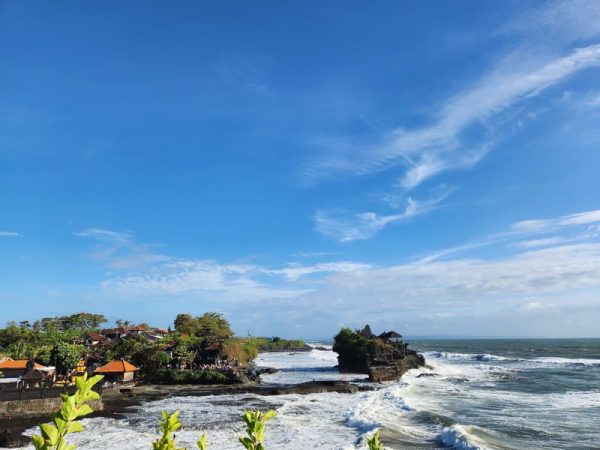Temple types
There are literally tens of thousands of temples in Bali, and new ones are being constructed all the time. Throughout much of the year they lie eerily deserted, but on the date of their anniversary festival they come to life in a brief but glorious burst of activity, as congregation adorns the temple elaborate gifts, dressed in their finest apparel.
We just have one word for temple, but the Balinese distinguish two important type. A sanggah(merajan in the refined language) refers to private or family temple, generally translated as “house temple.” Each family compound has one, containing shrines to the family’s deified ancestors (sanggah kemulan). Thus there are several hundred thousand house temple in Bali.
The other word for temple in Balinese is pura, originally a Sanskrit term referring to a town or palace. In Bali, the word pura has come to refer to temple in the public domain, generally located on the public land. These cannot always be neatly classified, but there are generally three types associated with the three most important foci of social organization on Bali-locale, irrigation cooperative (subak) and descent group.
Within the group based on locality are temples of the local village, as well as temples of greater regional and island – wide significance. Irrigation cooperative temples can belong to a single subak or to a whole group of subaks. And within the group of temples based on descent are temples supported by “clans” of greater or lesser degrees of ancestral depth, variously known as pura dadia, pura kawitan and pura padharman. Altogether there are at least 10,000 temples on Bali belonging to these various types.
Three village temples of special significance are the kahyangan tiga (“three sanctuaries”) – the pura puseh (“temple of origin”), at the upper end of the village, the pura desa (“village temple”) or pura bale agung (“great meeting hall temple”) in the village center, and the pura dalem (death temple or “temple of the mighty one”) lying near the cemetery and cremation grounds at the lower or seaward end of the village. These temples are linked with the gods of the Hindu Trinity: the pura puseh with Brahma the creator, the pura desa with Vishnu the preserver, and the pura dalem with Siwa the destroyer.
The famous temple sites that tourist visit are regional or island-wide temples. These include the “Mother Temple” of Besakih, high up on the slopes of Mt. Agung, as well as the major temples of Ulun Danu (Batur), Lempuyang, Gua Lawah, Ulu Watu, Batukaru, Pesering Jagat (Pejeng), Andakasa and Puncak Mangu. These are nearly all mountain or sea temples, marking the primary poles of the sacred landscape in Bali.
Lesser regional temples, numbering in the hundreds, are sometimes called pura dang kahyangan or “temples of the Sacred Ones” because they are associated with legendary priests who brought Hinduism to Bali from Java. Their supporting congregations are down from a wide area, and in the past such temples were often supported by local princely houses. Nowadays regional governments have taken on the same role. Important regional temples include Pura Sakenan, Pura Tanah Lot, Pura Kehen, Pura Taman Ayun and many others.

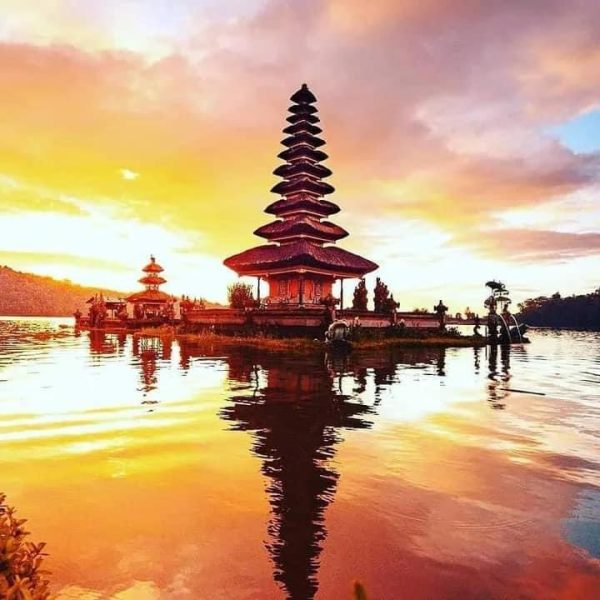
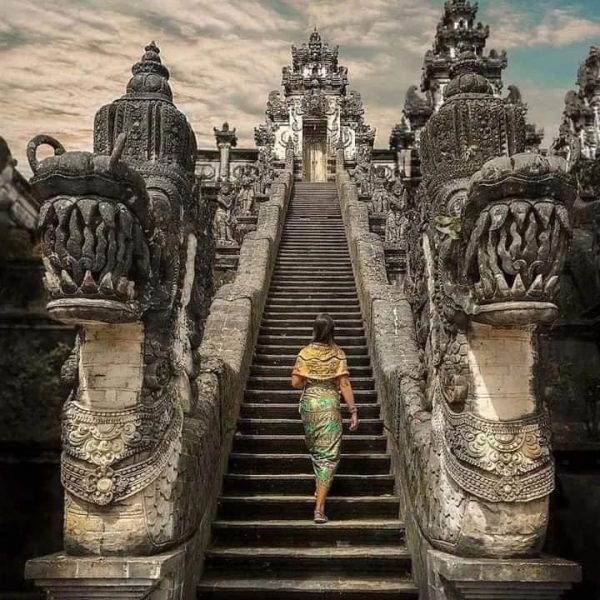
Shrines and Pavilions
A temple may contain just one or two shrines within a small courtyard, or it may contain dozens of shrines and other structures within two, or often three courtyards.
The innermost courtyard is the most sacred. Shrines are usually located here in two rows – one lining the mountain (kaja) side and the other lining the eastern (kangin) side. Toward the center of the courtyard is a large structure where the gods gather during rituals. Open pavilions for various purposes complete the arrangement.
Among the shrines lining the mountain-ward side one often finds a pair of small closed shrines (gedong) – one with an earth-enware dish on its roof, the other with a pointed roof. These honor protective deities of the greatest importance: Dewi Sri, goddess of rice and prosperity, and her consort Rambut Sedana, god of wealth. A small shrine with a deer’s head is called menjangan saluwang and honors the legendary priest Mpu Kuturan, or a deity called Bhatara Maospahit.
A particularly striking structure is the meru or Balinese pagoda, which has an odd numbers of roofs, up to a maximum of eleven. A meru honors a god or deified ancestor, depending on what kind of temple it is. It was probably introduced from Java during the 14th century.
In the mountain ward-eastward corner, between the rows of shrines, there is often an open seat-type shrine. In it’s fully developed form, adorned with cosmic turtle and serpents, this is a called a padmasana (“lotus throne”) and honors the high god Sanghyang Widhi in his manifestation as Siwa Raditya, the sun god. Modern Balinese Hindhuism stresses it’s monotheistic aspect, and the padmasana has recently become more prominent.
Temple festivals are held according to one of two calendrical system. When it’s appears on the 210-days wuku calendar, a festival is called an odalan; when it follows the lunar calendar, it is often referred to as an usaba. Various factors, such as local tradition and the size of the ritual, determine whether a festival is officiated by the temple’s own priest (pedanda)
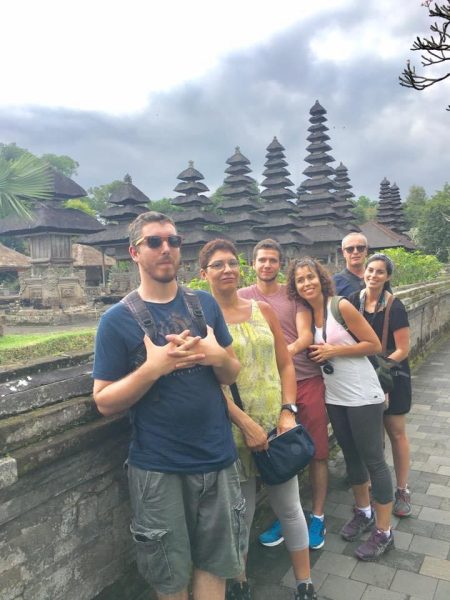
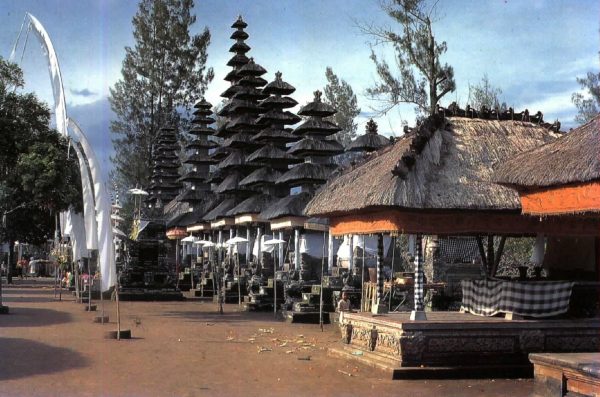
Temple in the sea
About 20 km west of Denpasar on the main highway, one arrives at the town of Kediri, where a large sign at the main intersection announces a turn-off to the southwest toward Pura Tanah Lot – the famous seaside temple in the south. Tanah means earth and Lot means south or sea (usually written Lod) – thus something like. “Temple of the Earth in the sea” is attended. It is actually constructed atop a large, jagged outcropping of rock just off the coast. It is accessible only during low tide. The temple itself is quite modest, consisting of two shrines with tiered roofs (7 and 3), a few small buildings and two pavilions.
Poisonous, black sea snakes live between the rocks and in caves along the coast. They guard the temple, but give the site a reputation of being “dangerous.” Nevertheless, many Balinese love to sit on the beach or on a bluff overlooking the temple in the late afternoon, watching the tides change and enjoying the silhouettes of the temple meru against the brilliant setting sun.
Like so many other temples in Bali, Pura Tanah Lot is connected with the famous brahman priest, Danghyang Nirartha, who wandered from Java to Bali in the 16th century. On one of this journeys he decided to sleep in this beautiful spot, and then afterwards advised the Balinese to erect a temple here. As mentioned above, this is one of the sad kahyangan or six most holy temples for all of Bali as well as for Tabanan district.
